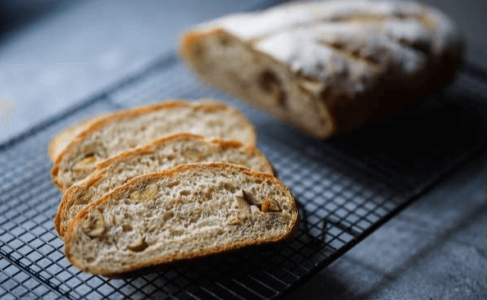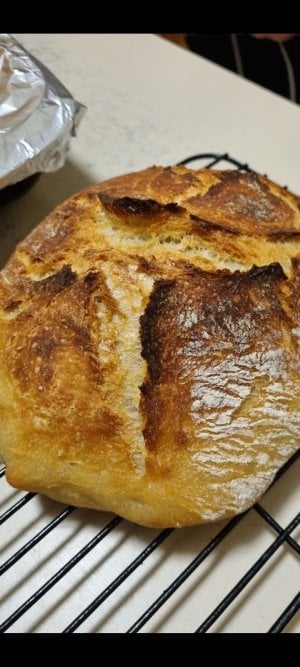The 'secret' to perfect homemade sourdough, according to scientists
- Replies 9
Baking has once again become an incredibly popular pastime, with many enjoying baking bread in particular.
Among the kinds of bread, sourdough is a favourite of many due to its crusty exterior, chewy inside, and unique flavour.
It's not complex—sourdough is made with just three ingredients: flour, water and a little bit of salt. So, why does it taste and smell just the way it does (delicious)?
Thanks to a team of researchers at the Technical University of Munich, we now know exactly what's going on behind the scenes to make it what it is.

Using the updated 'sensomics' (refers to the scientific study of sensory perception, particularly related to taste and smell) technique, the researchers identified the 10 key 'tastants' and 11 key 'odourants' combined into a sourdough 'essence'.
They found that salt and acetic, and lactic acid (which form during the fermentation process) were the critical components of the unique sourdough taste. Other taste compounds included potassium for a bitter flavour and compounds called d-fructose and l-glutamic acid.
The researchers also identified 11 odour compounds, such as cheesy smells, the buttery-smelling 2,3-butanedione, as well as compounds with vegetable-like scents and nutty aromas.
Compounds like hexanal, which smells like fresh-cut grass, and phenylacetaldehyde, with its sweet, honey-like scent, also contribute to the unique flavour of the bread.
The experts also looked at ways the bakers could potentially reduce how much salt went into the bread. For optimal taste, they suggested evenly distributing saltier doughs throughout a dough mixture.
That way, they say the bread's unique taste is still maintained, but the amount of sodium going into each loaf is reduced.
The findings may help artisan bakers create more consistent sourdoughs for customers to enjoy, as well as aid in the reduction of salt content used in bread recipes.
'We hope what we learned will help bakers create the best sourdough bread they can.' said the researchers.

Members, if you're in the mood for a kitchen adventure, why not try your hand at crafting your own sourdough? You might uncover a newfound passion—one that rewards you with not only a delectable loaf but also a fulfilling pastime in the process!
Why not try this recipe below?
Credit: ABC Australia.
Among the kinds of bread, sourdough is a favourite of many due to its crusty exterior, chewy inside, and unique flavour.
It's not complex—sourdough is made with just three ingredients: flour, water and a little bit of salt. So, why does it taste and smell just the way it does (delicious)?
Thanks to a team of researchers at the Technical University of Munich, we now know exactly what's going on behind the scenes to make it what it is.

Sourdough is made with just three ingredients: flour, water and a little bit of salt. Credit: Pexels/Cats Coming.
Using the updated 'sensomics' (refers to the scientific study of sensory perception, particularly related to taste and smell) technique, the researchers identified the 10 key 'tastants' and 11 key 'odourants' combined into a sourdough 'essence'.
They found that salt and acetic, and lactic acid (which form during the fermentation process) were the critical components of the unique sourdough taste. Other taste compounds included potassium for a bitter flavour and compounds called d-fructose and l-glutamic acid.
The researchers also identified 11 odour compounds, such as cheesy smells, the buttery-smelling 2,3-butanedione, as well as compounds with vegetable-like scents and nutty aromas.
Compounds like hexanal, which smells like fresh-cut grass, and phenylacetaldehyde, with its sweet, honey-like scent, also contribute to the unique flavour of the bread.
The experts also looked at ways the bakers could potentially reduce how much salt went into the bread. For optimal taste, they suggested evenly distributing saltier doughs throughout a dough mixture.
That way, they say the bread's unique taste is still maintained, but the amount of sodium going into each loaf is reduced.
The findings may help artisan bakers create more consistent sourdoughs for customers to enjoy, as well as aid in the reduction of salt content used in bread recipes.
'We hope what we learned will help bakers create the best sourdough bread they can.' said the researchers.
Key Takeaways
- A team at the Technical University of Munich in Germany has discovered the 21 essential chemical compounds that contribute to the unique taste and aroma of sourdough bread.
- Salt, acetic and lactic acid, which result from fermentation, were identified as the critical components of the unique sourdough taste, with additional compounds contributing to its unique smell, including molecules reminiscent of butter and fresh-cut grass.
- The research team used an updated version of a 'sensomics' technique to analyse the flavour compounds in sourdough bread, with the hope that this information could help bakers create more consistent and appealing sourdoughs for customers.
- The researchers also developed a new method for reducing sourdough bread's salt content, an approach that could help lower sodium intake while maintaining the bread's unique taste.
Members, if you're in the mood for a kitchen adventure, why not try your hand at crafting your own sourdough? You might uncover a newfound passion—one that rewards you with not only a delectable loaf but also a fulfilling pastime in the process!
Why not try this recipe below?
Credit: ABC Australia.








